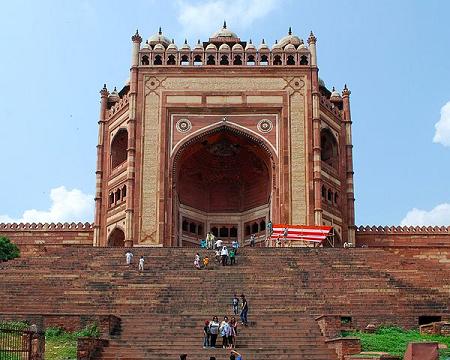|
Fatehpur
Sikri is a very beautiful town which is situated about 35 kms from the
south west of Agra, on the Jaipur-Agra road. Fatehpur Sikri was
founded in the 16th century by the Mughal Emperor Akbar. This city is
made of red sandstone and it is one of the most amazing medieval
cities of India.
The
foundation of Fatehpur Sikri was laid during 1571 and 1585. It is a
perfect example of Hindu and Mughal architecture. Important
attractions of the city are large gateways, palaces, fortifications,
Buland Darwaza, Jama Masjid, Buland Darwaza, Tomb of Salim Chisti,
Diwan-e-Khas, Diwan-e-Aam, Panch Mahal, Birbalís House and Jodha Bai's
Palace.
In the deseerted city of Fatehpur Sikri one can gain a clear insight
into the rematrkable character of Mughals. |

Buland Darwaza |
|
There is a
very exciting and wonderful history which is associated with Fatehpur
Sikri. Mughal emperor Akbar had many wives but had no successor. Due
to this, he met with many sacred people and finally to a famous Sufi
Saint Sheikh Salim Chisti who lived near Sikri in a remote area with
the hope that they will help him to fulfill his wishes to have a legal
heir. Salim Chisti gave his blessings to Akbar and very soon after
this a son was born to Akbar. Akbar named his son "Salim" after the
saint and built the magnificent Jami Masjid near the saint's home. If
Akbar had to be sanctified by a son, a sacrifice was to be made of a
very dear one according to the myths.
The
saint's son volunteered to be sacrificed so that the heir to the
throne could be born. Two cenatophs are there to the west of
the mosque, one of the saint and the other of the saint's infant son.
And thus Salim was born on 30th August, 1569 to the empress,
Mariam-uz-Zamani and the emperor announced to build a large city. Thus
the beautiful city of Fatehpur Sikri was founded on a stony ridge. But
due to lack of water, the Mughal emperor neglected the city and
shifted the capital to Lahore within 20 years. |
|
The
wonderful buildings of Fatehpur Sikri can be divided into two
categories namely, religious and secular.
Religious Buildings
The
religious buildings are Buland Darwaza and Jama Masjid -
Buland Darwaza - Buland Darwaza is the most amazing gateway of
India which stands about 176 feet high. The Buland Darwaza was founded
in the year 1602, to honor Akbar's conquest over Deccan. The doorway
is richly carved with rhymes from the Holy Quran cut in bold Arabic
letters.
Jama Masjid - It was founded in 1581. Entrance to the Mosque is
through the Buland Darwaza. Jama Masjid is elaborated and ornamented
in pure white marble.
Secular Buildings
The secular buildings are Mariam's House, Birbal's House, House of the
Turkish Sultana, Diwan-e-Khas, Panch Mahal, and Jodha Bai's Palace,
all of which portrays different architectural patterns.
Mariam's House - It is the residence of Rajput spouses of Akbar,
for their privacy it is constructed around a courtyard.
Panch Mahal - It is a 5 storied building. This building is built
for a specific purpose, it basically serves as a leisure room for
royal ladies. There are about 175 columns inside.
Birbal House - It is the dwelling of the most favorite minister
of Akbar. Prominent features of this dwelling are sunshades and the
brackets which support them.
Anup Talao - It is a ornamented pool with a central platform.
Other
attractions include: Ankh Micholi (the palace where Akbar used to play
hide and seek with the ladies of the harem, and which later became the
imperial treasury), Abdar Khana, Pachisi Court, Khawabgah (house of
dreams) etc.
|